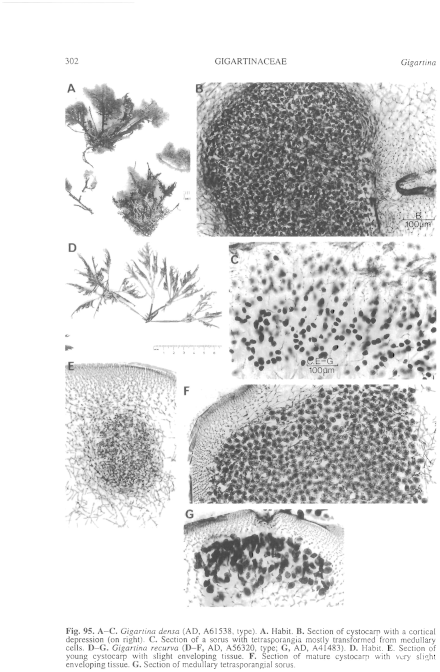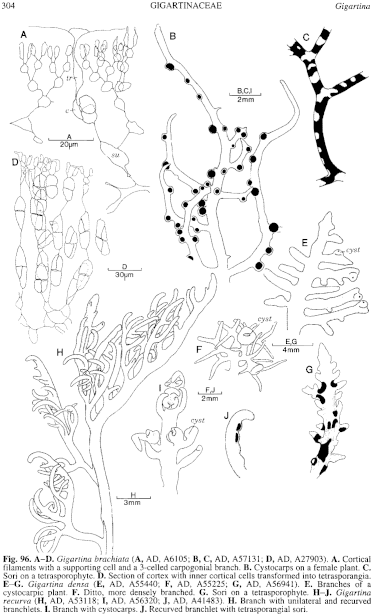|
|
|
|
|
|||||||||||
|
Electronic Flora of South Australia Species Fact Sheet
Phylum Rhodophyta – Class Florideophyceae – Order Gigartinales – Family Gigartinaceae
Synonyms
G. congesta Zanardini 1874: 502. J. Agardh 1876: 205. Setchell & Gardner 1934: 135. [NON G. congesta (Turner) Greville 1830: lviii = Areschougia congesta (Turner) J. Agardh.]
?G. pumila Zanardini 1874: 502 (nomen dubium).
Thallus (Fig. 95A) dark red, fading to yellow-brown, erect and rigid, 2–6 (–10) cm high, cartilaginous, with clumped axes densely branched above. Fronds with a terete to compressed percurrent axis 1.5–2 (–3) mm in diameter, with a few subdichotomous to lateral main branches, usually becoming naked below but with crowded pinnate (when well developed) to radial branches, usually with densely clustered branch ends; upper laterals and branchlets terete to slightly compressed, 0.5–1 mm broad, with acute apices. Holdfast discoid, 2–4 (–6) mm across; epilithic or on mussels. Structure of a dense cortex of slender, anticlinal, subdichotomous filaments, end cells 1–2 µm in diameter and L/D 2–3, and a medulla of anastomosing filaments 5–9 (–12) µm in diameter; the central filaments tend to be mainly longitudinal and broader.
Reproduction: Sexual thalli monoecious. Carpogonial branches 3-celled, situated on an inner cortical (supporting) cell. Cystocarps (Fig. 96E, F) 1–1.5 mm across, occurring laterally and subapically on slender, simple branchlets usually with a spinous apex, without involucral ramuli; carposporophyte (Fig. 95B) consisting of a filamentous matrix of scattered larger cells, with pit-connections scarcely enlarged, and numerous clusters of ovoid carposporangia 11–14 ilIT1 in diameter, surrounded by enveloping tissue, with the inner cells connected to gonimoblast cells but without transverse filaments, with the cortex forming a distinct depression outside the cystocarp. Spermatangial son inconspicuous, forming pale patches near young cystocarps, with elongate cortical cells each cutting off obliquely an elongate spermatangium which produces apically a single ovoid spermatium 1–2 µm in diameter.
Tetrasporangial sori (Fig. 96G) forming irregular patches on the surface and margins of branchlets, often as incomplete annuli; tetrasporangia (Fig. 95C) transformed from inner cortical and outer medullary cells, and also cut off laterally from these cells, ovoid, 15–25 µm in diameter, cruciately divided.
Type from Robe, S. Aust., uppermost sublittoral on reef edge W of jetty (Womersley, 7.xii.1991); holotype in AD, A61538 - Isotypes in "Marine Algae of southern Australia" No. 361.
Selected specimens: Belinda Beach, Middle I., Recherche Arch., W. Aust., uppermost sublittoral (Trudgen 838, 23.xi.1973; AD, A51697). Head of the Great Australian Bight, S. Aust., in shaded pool (Womersley, 4.ii.1954; AD, A19322). Point Sinclair, S. Aust., in crevice, upper sublittoral (Womersley, 8.ii.1954; AD, A19616). Elliston, S. Aust., low eulittoral in bay, shaded (Womersley, 15.i.1951; AD, A13699). Wanna, S. Aust., lower eulittoral (Womersley, 9.i.1984; AD, A55225). Pennington Bay, Kangaroo I., S. Aust., sublittoral fringe (Womersley, 22.viii.1954; AD, A19772). Cape Lannes, S. Aust., just below low tide level (Edyvane, 28.iv.1984; AD, A55435 and 21.vii.1984; AD, A56941). Blackfellows Caves, S. Aust., 1–2 m deep (Edyvane, 3.ii.1984; AD, A55440 and 18.ii.1985; AD, A56942). Lawrence Rock, Portland, Vic., in low pool (Beauglehole, 15.i.1960; AD, A24010). Bicheno, Tas., lower eulittoral (Wollaston, 21.ii.1986; AD, A57032).
Distribution: Recherche Arch., W. Aust., to Lawrence Rock, Portland, Vic., and the east coast of Tasmania, growing as small, dense, rigid tufts in the uppermost sublittoral on rough-water coasts.
Taxonomic notes: This species was first described as G. congesta Zanardini 1874, from Tasmania, but this name is pre-dated by Gigartina congesta (Turner) Greville 1830. It is now newly described as G. densa, referring to the very dense upper branching on the axes. The type of G. pumila Zanardini, from Port Phillip, Vic., in Museo Civico di Storia Naturale, Venice, has not been available but from the description is a small fragment and probably inadequate. It is therefore regarded as a nomen dubium.
G. densa is a distinctive, small but rigid, species found near low tide level on rough-water coasts. It is most closely related to G. brachiata, differing in its erect habit from a single holdfast, usually with clustered upper branches, the more external, protruding cystocarps, and tetrasporangia formed more from outer medullary cells together with ones formed laterally.
References:
AGARDH, J.G. (1876). Species Genera et Ordines Algarum. Vol. 3, Part 1 - Epicrisis systematis Floridearum, pp. i-vii, 1–724. (Weigel: Leipzig.)
GREVILLE, R.K. (1830). Algae Britannicae. (Maclachlan & Stewart: Edinburgh.)
SETCHELL, W.A. & GARDNER, N.L. (1934). De Gigartinis. Rev. Algol. 7, 131–138.
ZANARDINI, J. (1874). Phyceae Australicae novae vel minus cognitae. Flora (Regensburg) 57, 486–490, 497–505.
The Marine Benthic Flora of Southern Australia Part IIIA complete list of references.
Publication:
Womersley, H.B.S. (14 January, 1994)
The Marine Benthic Flora of Southern Australia
Rhodophyta. Part IIIA, Bangiophyceae and Florideophyceae (to Gigartinales)
Reproduced with permission from The Marine Benthic Flora of Southern Australia Part IIIA 1994, by H.B.S. Womersley. Australian Biological Resources Study, Canberra. Copyright Commonwealth of Australia.
Illustrations in Womersley Part IIIA, 1994: FIGS 95 A–C, 96 E–G.

Figure 95 enlarge
Fig. 95. A–C. Gigartina densa (AD, A61538, type). A. Habit. B. Section of cystocarp with a cortical depression (on right). C. Section of a sorus with tetrasporangia mostly transformed from medullary cells. D–G. Gigartina recurva (D–F, AD, A56320, type; G, AD, A41483). D. Habit. E. Section of young cystocarp with slight enveloping tissue. F. Section of mature cystocarp with very slight enveloping tissue. G. Section of medullary tetrasporangial sorus.

Figure 96 enlarge
Fig. 96. A–D. Gigartina brachiata (A, AD, A6105; B, C, AD, A57131; D, AD, A27903). A. Cortical filaments with a supporting cell and a 3-celled carpogonial branch. B. Cystocarps on a female plant. C. Sori on a tetrasporophyte. D. Section of cortex with inner cortical cells transformed into tetrasporangia. E–G. Gigartina densa (E, AD, A55440; F, AD, A55225; G, AD, A56941). E. Branches of a cystocarpic plant. F. Ditto, more densely branched. G. Sori on a tetrasporophyte. H–J. Gigartina recurva (H, AD, A53118; I, AD, A56320; J, AD, A41483). H. Branch with unilateral and recurved branchlets. I. Branch with cystocarps. J. Recurved branchlet with tetrasporangial sori.

|
Email Contact: State Herbarium of South Australia |

|